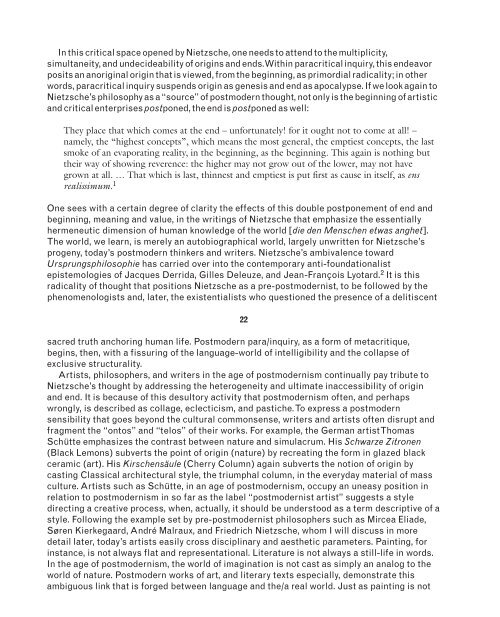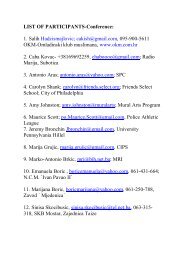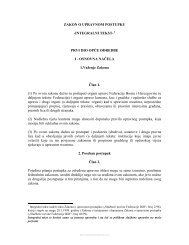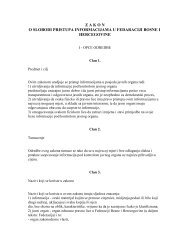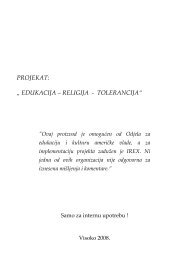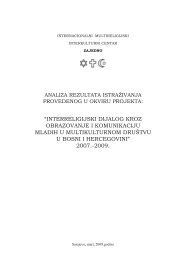What I have to say is largely in support of the following proposition: Literary criticism should becompleted by criticism from a definite ethical <strong>and</strong> theological st<strong>and</strong>point. In so far as in any age thereis common agreement on ethical <strong>and</strong> theological matters, so far can literary criticism be substantive.In ages like our own, in which there is no such common agreement, it is the more necessary forChristian readers to scrutinize their reading, especially of works of imagination, with explicit ethical<strong>and</strong> theological st<strong>and</strong>ards.(T.S. Eliot, “<strong>Religion</strong> <strong>and</strong> Literature,” Selected Essays)What we found especially reassuring was this: when the sun was right overhead a new group of mencame to the shore in an egg from one of the seabirds <strong>and</strong> dragged an object from the shell. It lookedlike the tall trunk of a tree, but it had no leaves, only branches at the top. They all toiled together todrag the thing up the hill, which rises from the rocks to far above the dunes <strong>and</strong> bushes. We watchedin awe, for it had long been a sacred place to us, marked untellable years before by one of ourw<strong>and</strong>ering tribes with a cairn: one of the innumerable graves of our savior hero, the hunter Heitsi-Eibib, who had died many times, yet never died. What sacrilege were these intruders about tocommit? We were trembling in anger <strong>and</strong> trepidation as we watched the strange men opening up adeep hole among the rocks of our cairn. Into this pit they lowered their bare tree, then carefullysteadied it in place with rocks they had removed, adding others to it, raising the mound to the heightof a man.(André Brink, The Cape of Storms: The First Life of Adamastor)21The fruits of the news of the death of God do away with the flower of His death [la fleur de mort] aswell as the bud of His life [le bourgeon de vie]. For alive or dead, it is still a question of belief: theelement of belief has not been ab<strong>and</strong>oned [on ne sort pas de l’élément de la croyance]. Theannouncement of the father’s death constitutes a last belief, “a belief by virtue of non-belief” aboutwhich Nietzsche says, “This violence always manifests the need for belief, for a prop, for structure”Œdipus-as-structure.(Deleuze <strong>and</strong> Guattari, Anti-Œdipus)ANTI-STRUCTURE<strong>Postmodern</strong> para/inquiry contributes to the reading of the Western literary, philosophical, <strong>and</strong>theological tradition in so far as it articulates, as Deleuze <strong>and</strong> Guattari describe it, an(anti)structurality of language that is heterogrammatically revolutionary <strong>and</strong> founded uponNietzsche’s pronouncement of the death of God. Traditional critical discourses within thehumanities, with their concern for an ethical <strong>and</strong> theological foundation (as evidenced byEliot’s underst<strong>and</strong>ing of the relationship between religion <strong>and</strong> literature), often are directedby the search for an origin, a Nietzschean “prop,” that promises to synthesize language <strong>and</strong>the/a real world. In the age of postmodernism, with its unyielding violence upon linearity,linkages, <strong>and</strong> redemptive teleologies, one begins the process of inquiry into the status ofmeaning <strong>and</strong> value unencumbered by a desire for origin or the burdensome inevitability ofepistemological, political, or theological destination.
In this critical space opened by Nietzsche, one needs to attend to the multiplicity,simultaneity, <strong>and</strong> undecideability of origins <strong>and</strong> ends.Within paracritical inquiry, this endeavorposits an anoriginal origin that is viewed, from the beginning, as primordial radicality; in otherwords,paracriticalinquirysuspendsoriginasgenesis<strong>and</strong>endasapocalypse.IfwelookagaintoNietzsche’sphilosophyasa“source”ofpostmodernthought,notonlyisthebeginningofartistic<strong>and</strong> critical enterprises postponed,theendispostponed as well:They place that which comes at the end – unfortunately! for it ought not to come at all! –namely, the “highest concepts”, which means the most general, the emptiest concepts, the lastsmoke of an evaporating reality, in the beginning, as the beginning. This again is nothing buttheir way of showing reverence: the higher may not grow out of the lower, may not havegrown at all. … That which is last, thinnest <strong>and</strong> emptiest is put first as cause in itself, as ensrealissimum. 1One sees with a certain degree of clarity the effects of this double postponement of end <strong>and</strong>beginning, meaning <strong>and</strong> value, in the writings of Nietzsche that emphasize the essentiallyhermeneutic dimension of human knowledge of the world [die den Menschen etwas anghet].The world, we learn, is merely an autobiographical world, largely unwritten for Nietzsche’sprogeny, today’s postmodern thinkers <strong>and</strong> writers. Nietzsche’s ambivalence towardUrsprungsphilosophie has carried over into the contemporary anti-foundationalistepistemologies of Jacques Derrida, Gilles Deleuze, <strong>and</strong> Jean-François Lyotard. 2 It is thisradicality of thought that positions Nietzsche as a pre-postmodernist, to be followed by thephenomenologists <strong>and</strong>, later, the existentialists who questioned the presence of a delitiscent22sacred truth anchoring human life. <strong>Postmodern</strong> para/inquiry, as a form of metacritique,begins, then, with a fissuring of the language-world of intelligibility <strong>and</strong> the collapse ofexclusive structurality.Artists, philosophers, <strong>and</strong> writers in the age of postmodernism continually pay tribute toNietzsche’s thought by addressing the heterogeneity <strong>and</strong> ultimate inaccessibility of origin<strong>and</strong> end. It is because of this desultory activity that postmodernism often, <strong>and</strong> perhapswrongly, is described as collage, eclecticism, <strong>and</strong> pastiche. To express a postmodernsensibility that goes beyond the cultural commonsense, writers <strong>and</strong> artists often disrupt <strong>and</strong>fragment the “ontos” <strong>and</strong> “telos” of their works. For example, the German artist ThomasSchütte emphasizes the contrast between nature <strong>and</strong> simulacrum. His Schwarze Zitronen(Black Lemons) subverts the point of origin (nature) by recreating the form in glazed blackceramic (art). His Kirschensäule (Cherry Column) again subverts the notion of origin bycasting Classical architectural style, the triumphal column, in the everyday material of massculture. Artists such as Schütte, in an age of postmodernism, occupy an uneasy position inrelation to postmodernism in so far as the label “postmodernist artist” suggests a styledirecting a creative process, when, actually, it should be understood as a term descriptive of astyle. Following the example set by pre-postmodernist philosophers such as Mircea Eliade,Søren Kierkegaard, André Malraux, <strong>and</strong> Friedrich Nietzsche, whom I will discuss in moredetail later, today’s artists easily cross disciplinary <strong>and</strong> aesthetic parameters. Painting, forinstance, is not always flat <strong>and</strong> representational. Literature is not always a still-life in words.In the age of postmodernism, the world of imagination is not cast as simply an analog to theworld of nature. <strong>Postmodern</strong> works of art, <strong>and</strong> literary texts especially, demonstrate thisambiguous link that is forged between language <strong>and</strong> the/a real world. Just as painting is not
- Page 2: PARA/INQUIRY“For those of us who
- Page 5 and 6: First published 2000by Routledge11
- Page 8 and 9: CONTENTSList of figures ixAcknowled
- Page 10: FIGURES3.1 Questioner of the Sphinx
- Page 14: Posting
- Page 17 and 18: meaning that founds philosophical i
- Page 20: CHAPTER 1Paralogies
- Page 23 and 24: Lyotard’s enjeu, Deleuze and Guat
- Page 25 and 26: In his book Pararealities: The Natu
- Page 27 and 28: acquittal. The horror of the text i
- Page 29 and 30: writer therefore work without rules
- Page 32: CHAPTER 2Parastructures of the sacr
- Page 37 and 38: Joyce’s Finnegans Wake the exempl
- Page 39 and 40: Deservedly confin’d into this roc
- Page 41 and 42: story of the sacred? Is there but o
- Page 44 and 45: The aspects of things that are most
- Page 46 and 47: AUTHENTICITYThe Sphinx has symboliz
- Page 48 and 49: The fact that I exist and have an i
- Page 50 and 51: connection with the Columbian Expos
- Page 52 and 53: through the sacred, so does the com
- Page 54 and 55: appropriation of his thought and of
- Page 56 and 57: use or civil meaning of the word (t
- Page 58 and 59: does not mean that one is sidestepp
- Page 60: of the twentieth century. As Lyotar
- Page 64 and 65: The sacred of the archaic world was
- Page 66 and 67: possibility for an expression of ex
- Page 68 and 69: the actual frame of the panels, the
- Page 70 and 71: space of the painting, and, second,
- Page 72 and 73: much a part of scholarship today. A
- Page 74 and 75: not merely interesting footnotes to
- Page 76 and 77: many to see Eliade as a mystic who
- Page 78 and 79: phenomenology. Eliade’s arrival i
- Page 80 and 81: of the sacred as a child in Romania
- Page 82 and 83: discursive structure to relinquish
- Page 84 and 85:
autonomy of the work of art. But ha
- Page 86:
CHAPTER 5Para Shoah
- Page 89 and 90:
Faurisson reveals that the Shoah is
- Page 91 and 92:
MEMORIES OF FORGETTINGCertainty is
- Page 93 and 94:
political. Each of these ground(ing
- Page 95 and 96:
totalizing discourses or a determin
- Page 97 and 98:
Kantian wound often move toward a q
- Page 99 and 100:
Secret fauna and flora which the re
- Page 102:
CHAPTER 6Parasacred ground(ing)s
- Page 105 and 106:
often exist outside (the pagus) the
- Page 107 and 108:
graveyard. The sacred disfigures,be
- Page 109 and 110:
death, which is another repetition
- Page 111 and 112:
able to choose from a range of poss
- Page 113 and 114:
eligious. Mary’s presence as a mi
- Page 115 and 116:
As one walks through a cemetery, ti
- Page 117 and 118:
104Figure 6.15b Clinging to the Cro
- Page 120 and 121:
To think not is to linger with a ne
- Page 122 and 123:
PARASACRED IMAGESNor does one need
- Page 124 and 125:
irreverent piety in so far as eachr
- Page 126:
CHAPTER 8EpilogueParaultimacy
- Page 129 and 130:
The steps, the corridor, to the plo
- Page 131 and 132:
GLOSSARYI should say that in so far
- Page 133 and 134:
The early writings of the French ph
- Page 135 and 136:
NOTESPOSTING1 Michel Montaigne, Apo
- Page 137 and 138:
metaphysical notion of effectivespa
- Page 139 and 140:
and probably goes back to helios.Ea
- Page 141 and 142:
“compensate” the rigidity of th
- Page 143 and 144:
GLOSSARY1 Peter A. Angeles writes(H
- Page 145 and 146:
Stanford: Stanford University Press
- Page 147 and 148:
Riverside Shakespeare edn, Boston:H
- Page 149 and 150:
Carroll, Lewis 23cemeteries 93, 101
- Page 151 and 152:
painting 58; laughter as epiphany 5
- Page 153 and 154:
“paraexperience” 83, 86; the po
- Page 155 and 156:
postmodernism: authenticity 33;ceme
- Page 157 and 158:
Thousand Plateaus, A (Gilles Deleuz


